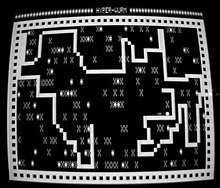Snake (video game genre)

Snake is a genre of action video games where the player maneuvers the end of a growing line, often themed as a snake. The player must keep the snake from colliding with both other obstacles and itself, which gets harder as the snake lengthens.
The genre originated in the 1976 competitive arcade video game Blockade from Gremlin Industries where the goal is to survive longer than the other player. Blockade and the initial wave of clones that followed were purely abstract and did not use snake terminology. The concept evolved into a single-player variant where a line with a head and tail gets longer with each piece of food eaten—often apples or eggs—increasing the likelihood of self-collision. The simplicity and low technical requirements of snake games have resulted in hundreds of versions, some of which have the word snake or worm in the title. The 1982 Tron arcade video game, based on the film, includes snake gameplay for the single-player Light Cycles segment, and some later snake games borrow the theme.
After a version simply called Snake was preloaded on Nokia mobile phones in 1998, there was a resurgence of interest in snake games.
Gameplay
[edit]
The original Blockade from 1976 and its many clones are two-player games. Viewed from a top-down perspective, each player controls a "snake" with a fixed starting position. The "head" of the snake continually moves forward, unable to stop, growing ever longer. It must be steered left, right, up, and down to avoid hitting walls and the body of either snake. The player who survives the longest wins. Single-player versions are less prevalent and have one or more snakes controlled by the computer, as in the light cycles segment of the 1982 Tron arcade game.
In the most common single-player game, the player's snake is of a certain length, so when the head moves the tail does too. Each item eaten by the snake causes the snake to get longer. Snake Byte has the snake eating apples. Nibbler has the snake eating abstract objects in a maze.
History
[edit]

The Snake genre began with the 1976 arcade video game Blockade[2][3] developed and published by Gremlin Industries.[4] It was cloned as Bigfoot Bonkers the same year. In 1977, Atari, Inc. released two Blockade-inspired titles: the arcade game Dominos and Atari VCS game Surround.[5] Surround was one of the nine Atari VCS launch titles in the US and was sold by Sears under the name Chase. That same year, a similar game was launched for the Bally Astrocade as Checkmate.[6] Mattel released Snafu for the Intellivision console in 1982.
The first known home computer version, Worm, was programmed by Peter Trefonas for the TRS-80 and published by CLOAD magazine in 1978.[2] Versions followed from the same author for the PET and Apple II. An authorized version of the Hustle arcade game, itself a clone of Blockcade, was published by Milton Bradley for the TI-99/4A in 1980.[7]
The single-player Snake Byte was published in 1982 for Atari 8-bit computers, Apple II, and VIC-20; a snake eats apples to complete a level, growing longer in the process. In Snake for the BBC Micro (1982), by Dave Bresnen, the snake is controlled using the left and right arrow keys relative to the direction it is heading in. The snake increases in speed as it gets longer, and there is only one life.
Nibbler (1982) is a single-player arcade game where the snake fits tightly into a maze, and the gameplay is faster than most snake designs. Another single-player version is part of the 1982 Tron arcade game, themed with light cycles. It reinvigorated the snake concept, and many subsequent games borrowed the light cycle theme.
Starting in 1991, Nibbles was included with MS-DOS for a period of time as a QBasic sample program. In 1992, Rattler Race was released as part of the second Microsoft Entertainment Pack. It adds enemy snakes to the familiar apple-eating gameplay.
Legacy
[edit]In 1996, Next Generation ranked it number 41 on their "Top 100 Games of All Time", citing the need for both quick reactions and forethought. In lieu of a title for a specific version, they listed it as "Snake game" in quotes.[8]
On November 29, 2012, the Museum of Modern Art in New York City announced that the Nokia port of Snake was one of 40 games that the curators wished to add to the museum's collection in the future.[9]
References
[edit]- ^ Tieturi, February 1985. ISSN 0780-9778
- ^ a b Gerard Goggin (2010), Global Mobile Media, Taylor & Francis, p. 101, ISBN 978-0-415-46917-3, retrieved April 7, 2011
- ^ Rusel DeMaria & Johnny L. Wilson (2003). High score!: the illustrated history of electronic games (2 ed.). McGraw-Hill Professional. p. 24. ISBN 0-07-223172-6. Retrieved April 7, 2011.
- ^ "Blockade video game, Gremlin Ind, inc. (1976)". Arcade-history.com. April 4, 2008. Archived from the original on June 11, 2011. Retrieved November 4, 2011.
- ^ Blockade at the Killer List of Videogames
- ^ Rusel DeMaria & Johnny L. Wilson (2003). High score!: the illustrated history of electronic games (2 ed.). McGraw-Hill Professional. p. 48. ISBN 0-07-223172-6.
- ^ "Retrogaming Times Monthly 7". My.stratos.net. January 1, 2005. Archived from the original on September 22, 2011. Retrieved November 4, 2011.
- ^ "Top 100 Games of All Time". Next Generation. No. 21. Imagine Media. September 1996. pp. 55–56.
- ^ "MoMA | Video Games: 14 in the Collection, for Starters". Archived from the original on September 8, 2015. Retrieved March 24, 2016.
